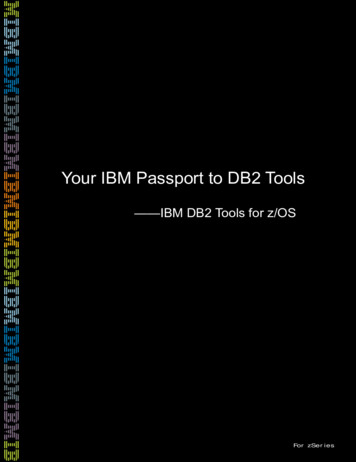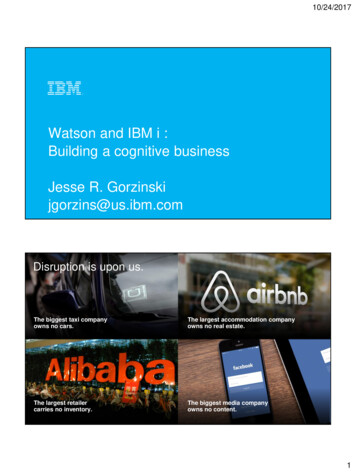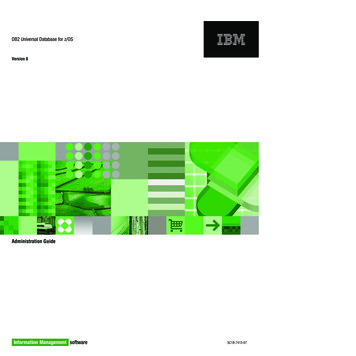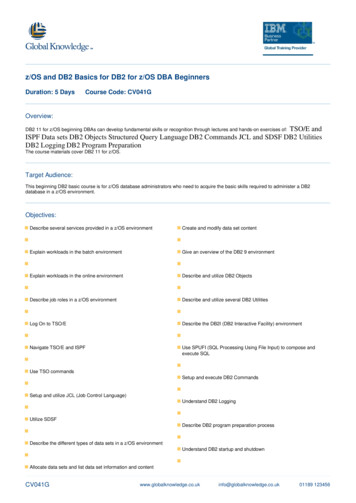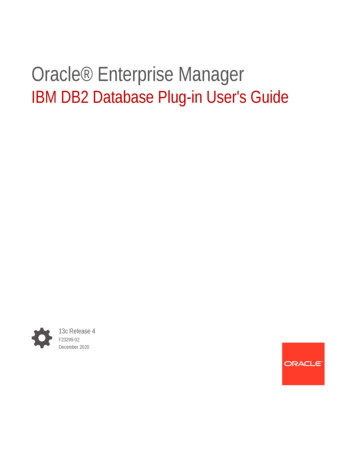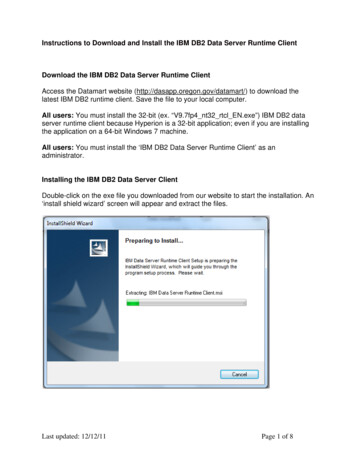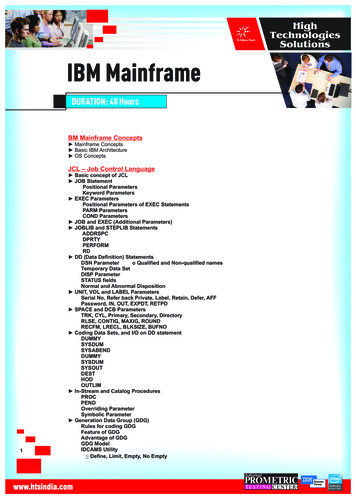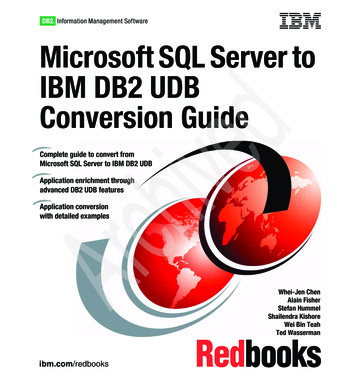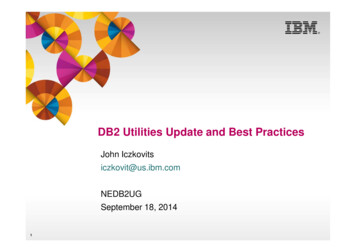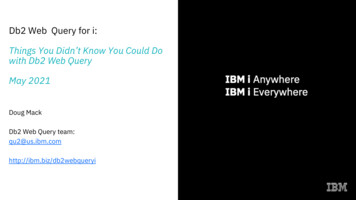
Transcription
Automated Conversions to IBM DB2 for z/OSIBM Redbooks Solution GuideBusiness agility is essential to client success in the fast-paced, competitive, and highly regulated globalbusiness climate of today. To grow and thrive, clients must effectively adopt and apply modern techniques(including analytics) to gain and sustain a competitive edge. An inflexible technology that is not based onstandards hinders the ability of a client to meet its business needs.IBM DB2 for z/OS and IBM System z are an ideal and logical target for migrations fromprerelational databases. New and existing clients rely on DB2 for z/OS and System z for theirunsurpassed total system reliability, availability, serviceability, and security. Demonstrated benefitsinclude exceptional availability and scalability, a superior level of protection for business-critical data andapplications, ease of integration and management across platforms, and reduced infrastructurecomplexity.Today the DB2 family of products (see Figure 1) offers an integrated end-to-end solution. It covers allplatforms and includes existing data, from which clients can draw large benefits.Figure 1. DB2 solutionsAutomated Conversions to IBM DB2 for z/OS1
Did you know?In the past, the amount of manual rewrite work needed to migrate a prerelational database andapplication far exceeded the work that was done by automated tools. However, with experience,innovations, and time, this dynamic changed. The advent of highly automated conversion solutions andmethods made prerelational conversions viable and repeatable. This change reduced the amount of timeneeded, the risks involved, and the costs of the migration process.Clients use automated conversion solutions to successfully migrate to modern platforms, such as DB2 forz/OS and System z. Several significant migrations of prerelational database to DB2 for z/OS have beencompleted, and many more are in progress. This trend is expected to continue as maturing conversiontechnologies become more popular and are widely accepted because of successful migrations.Business valueRelational databases are the superior data stores of choice for over 25 years. Relational technology is themethod of choice for storing large amounts of data with flexibility and easy access to data with a commonlanguage, Structured Query Language (SQL). Data stored in tables is accessible and is manipulated bySQL. This data accessibility, when combined with a language suitable for users, results in reducedmaintenance and greater productivity.Today’s IT shops are complicated. You likely support multiple types of hardware and software solutions.Although mean time between failures (MTBF) continues to improve, numerous components present theopportunity for a single point of failure.DB2 for z/OS and the System z platform offer the foundation of resiliency for your environment, keepingyour IT assets available to your internal and external customers. DB2 for z/OS and the System z platformprovide the architecture to maintain maximum availability, when problems occur, and to adjust tochanging and unpredictable workloads.DB2 is integrated into the System z operating system (z/OS) software and hardware. Through thisintegration, DB2 can fully use the performance features of the underlying hardware and software. Assuch, DB2 delivers a level of performance that is unmatched by other mainframe-based relationaldatabase management system (RDBMS) products. Because mainframe-based RDBMS products mustsupport work that originates from transaction processing monitors and from distributed systems (such asa client/server), the RDBMS must provide well-defined, efficient interfaces to those systems to facilitateapplication performance. DB2 provides these interfaces that support both mainframe transactionprocessing monitors, such as IBM CICS with the DB2 Adapter from IBM, and client/server systems, withsupport for stored procedures. These interfaces are well-designed and efficient, and they distinguish DB2as the enterprise server of choice.Solution overviewAs companies benefited from automation, they developed many applications that use customizedsoftware to run their business. Most of these applications use 3270 screen interfaces, large overnightbatch jobs, and DBMS or flat files that are prerelational in terms of how data is organized and accessed.With the advent of browser interfaces, RDBMS, and service-oriented architectures (SOA) that supportmore flexible access to information, many new development options are available.To take advantage of these development options, companies are looking at alternatives to convert fromtheir prerelational DBMS to a relational DBMS such as DB2 for z/OS. A manual conversion is onealternative, but most companies choose an approach that uses the automated conversion tools. Thisapproach offers the following benefits:Automated Conversions to IBM DB2 for z/OS2
Application source code maintenance is easier because only the call structure is changed. Employees are familiar with converted programs. The user interface often remains unchanged. The conversion process is completed quickly and with less risk. The results of the conversion are easier to test and verify because application functionality is thesame. The skills and expertise of client personnel are used. Changes to data and program structures are standardized. Program and database changes during the conversion are accommodated. The conversion process is documented in a before log and after log. Most automated conversion tools scan the program source code and database structures to generatereports. The reports are used to understand the application relationships for conversion decisions,identify missing and duplicate programs, and identify program interfaces for testing.An automated conversion requires selection of a vendor to provide the tools to convert the data and theapplications. IBM partners with several vendors to assist companies with conversion from prerelationaldatabases to DB2 for z/OS. After a vendor is identified, database conversions typically involve fourstages, as shown in Figure 2.Figure 2. The four stages of conversionAutomated Conversions to IBM DB2 for z/OS3
Each stage has the following primary objectives: The assessment stage involves analysis of your existing environment, including the database and theapplications, to arrive at an estimate for the conversion effort to determine the initial project scope andbudget. The pilot stage identifies a small group of transactions, programs, and data. It uses those componentsto perform a small conversion that acts as a feasibility study and provides learning points for thecomplete conversion. The conversion stage is the culmination of the work that was completed in stage 1 and stage 2.Project planning, coexistence, testing, change control, database design, code conversion, andmanual rework are done to complete the conversion to the new database. The post-conversion activities stage allows companies to perform more activities upon the converteddatabase. It also allows applications to take advantage of further database tuning, more usage ofrelational functionality, a more relational data model, application rearchitecture, and usage ofdatabase tools.Solution architectureThe automated conversion approach uses the customer source code, data definitions, and data as inputto a conversion tool. The tool then applies conversion rules that are provided by the customer during theconversion stages. The tool generates the converted source code and data and then, generates the DB2data definition language (DDL) statements that are required to create the DB2 database. Figure 3illustrates this process.Figure 3. Solution architectureThe automated conversion approach requires a thorough understanding of the existing data andapplications. In some cases, the format of the data in the prerelational database does not always fit intoan equivalent DB2 data format. Dates and times are an example. By using DB2, you can store data in adate and time format, with strict requirements that the data must conform to valid dates and times. Theprerelational database might not have such strict requirements. In these cases, you must defineconversion rules and provide them as input to the conversion tool.Automated Conversions to IBM DB2 for z/OS4
The conversion tool applies all the rules that are supplied to arrive at the converted source code, DDLstatements, and converted data for loading into DB2. The customer then uses their DB2 environment tocreate the database (by running the DDL statements), to load the database (by using the databaseextracts), and to prepare the converted source code.Tests of the conversion process might identify issues in any of the three components that are converted.After each test, the customer must modify the conversion rules to correct any issues and then rerun theconversion process. This testing process is likely to involve multiple iterations of rule definition andsubsequent testing before all the conversion rules are correct for the data and applications that are beingconverted.Usage scenariosCustomers choose to convert to DB2 for z/OS most often for the following reasons: Users or external customers demand access to relational data.They want to simplify the number of supported database platforms.They lack available customer staff who are skilled in DBMS.Application agility is needed to meet changing business and technical demands that require frequentprogramming and data model enhancements.DB2 for z/OS provides a robust database and supporting tools to address the reasons that customersconvert from their prerelational databases as the following example demonstrates.A large government institution was faced with the need to modernize its IT infrastructure. This customer'sIntegrated Database Management System (IDMS) application was converted from VSAM in the 1980s. Asthe customer base increased and data access requirements expanded, becoming more complex,changing the application and supporting database to meet regulatory compliance became morechallenging. Changes often included the use of the same field for multiple purposes or the use of fillerfields to hold data. In addition, support for the installed version of the IDMS software was scheduled toend within a few years, and the customer did not want to pay for both DB2 and IDMS license and supportcharges.In late 2007, the customer initiated a project to convert from IDMS to DB2 for z/OS and to evaluateautomation tool vendors and conversion support services. The sheer size of the conversion effort dictatedthat an automation conversion approach for the project must be found. The following statistics of theproject reinforced the need for an automated approach: Approximately 7 million lines of codeOver 1,400 batch programsOver 400 CICS programsAlmost 4 terabytes of dataThe customer selected a conversion vendor and contracted with IBM Information Management (IM) LabServices to provide database consulting services throughout the conversion effort. IM Lab Services wasinvolved in the database design, application design, testing, implementation, and post-production tuningefforts. IM Lab Services also provided customized DB2 workshops with hands-on labs for databaseadministrators and application developers.After the customer selected its conversion vendor and IBM services were assigned to the project, theconversion project started. The project consisted of the following stages:Automated Conversions to IBM DB2 for z/OS5
Identifying and conducting a pilot projectoThe customer identified a self-contained application to be part of the pilot, and the customer andthe conversion vendor agreed to a contract to conduct a pilot project. The following goals of thepilot project were identified:Demonstrate the capabilities of the conversion tool.Verify the compatibility of the tool with the environment of the customer.Identify problem areas in preparation for the larger conversion effort.o This experience and knowledge was used throughout the subsequent steps of the largerconversion effort.Automated assessmentA full analysis of all application and database components was performed to estimate the scope of theconversion. This process was conducted iteratively because some components were identified asmissing whenever the assessment was run. The components were missing because some sourcecode or jobs that were found in nonstandard libraries were not provided to the conversion vendor. Theoutput of this step included an estimate of the scope of the conversion and reports that identified thecomponents to be converted. It also included a project plan that detailed the steps of the project andthe process to collect the components targeted for conversion. Collecting, converting, and customizing the application and databaseoThe conversion vendor ran jobs to collect the IDMS components necessary for the conversion:source code, copybooks, job control language (JCL), CICS maps, database definitions, and data.All IDMS components were processed by the automated conversion tool to produce theequivalent DB2 components. The new components were then sent to the customer.oAt the beginning of this production step, certain business rules were predefined as input to theconversion process. These rules allowed for renaming fields to conform to DB2 standards and fordefining the manner in which differences in IDMS and DB2 data types were managed.oIn addition, some customization was conducted to determine which buffer pools to use and topartition certain tables. After the rules were defined and the converted applications and databasewere returned, the DB2 objects were created.Application and database testingoIn this stage, application and data conversion testing were conducted simultaneously. For thesetests, small amounts of data were loaded into unit test environments to allow application testers tobegin their analysis. At the same time, tests of DB2 LOAD utilities were run on the completed setof data to identify any data conversion errors or DDL errors.oThe testing continued through multiple iterations. Testing progressed through unit test, systemtest, and performance test phases. All defects were logged in to a defect tracking system, witheach defect identified by a defect number. Regular weekly meetings were held with theconversion vendor to review the testing results and any defects that were open.Performance testingoThroughout the testing phases, applications that were potential performance bottlenecks wereidentified. Individual teams were organized to address online performance issues and batchperformance issues.oThe online performance testing identified a mix of transactions that were deemed critical foronline performance. Automated testing software was used to capture the transaction mix andrerun the mix as needed after program or database configuration changes were made.oThe batch testing identified the longest running batch jobs within IDMS. Equivalent batch jobs thatwere run within DB2 also were identified and the difference between the two sets of batch jobswas measured. Decisions were then made about which programs must be rewritten and whichjobs could be addressed by database tuning.Automated Conversions to IBM DB2 for z/OS6
Implementation testsoSeveral implementation dry-run tests were conducted to validate the production implementationprocess. The tests also provided an estimate of the amount of time that is needed to complete theproduction implementation. The following tasks were included in the tests:Running the entire data extract and load processRunning the processes to switch from the IDMS application load libraries to the DB2application load librariesTesting the new code with the converted dataBacking out the load libraries to point the application back to the IDMS database oThese implementation tests required considerable planning. The tests included all of theconversion process personnel, including application developers, database administrators, CICSadministrators, testers, users, operators, security administrators, change management staff, andproject management staff.oThe lessons learned from each test were documented and changes to the process were appliedto next steps. These changes minimized the chance for errors during production implementation.Production implementationoThe production implementation was completed during a holiday weekend. The same steps thatwere conducted during the implementation tests also were conducted in the productionenvironment. Initial validation testing was conducted to ensure that there were no issues and noneed to roll back to the IDMS version of the applications and data. After the validation testing wascompleted and a decision was made to start production, batch processing began.oTeams were identified to monitor both the batch and online workload during the first few weeks ofthe processing. The conversion vendor also provided onsite support for most of the first weekafter the implementation was complete. The few problems that were found were addressedquickly. Most problems occurred when JCL was translated between the test environment and theproduction environment.Post-conversion tuningoPerformance data that was captured for the first few online and batch cycles was reviewed toidentify areas of concern. The online transactions and batch jobs were completed within theaccepted service level agreements (SLAs) for elapsed time. However, the processor cost formost jobs was considerably higher than the cost under IDMS. The conversion wassame-to-same. Therefore, an increase in the processor cost was expected because the access ofthe DB2 data was left similar to how IDMS accesses data.oChanges were made to take advantage of SQL functionality by replacing programmatic joins withSQL joins and by including filtering logic in the SQL instead of in the program.Relational redesignoAfter the conversion was complete and was stable in production for a few months, an effort beganto determine how the application and database might take advantage of true relational databasecapabilities. This analysis step is a long-term project that involves the following tasks:Reduce dependency on generated I/O modulesTake advantage of SQL capabilitiesRemove any IDMS-type constructs from the database designoThe final goal of the redesign is to have an application and database that are truly relational. Thetime and effort to incorporate this change as part of the first phase unnecessarily lengthens theproject. The effort to make these changes up front also increases the dependency on IDMSbeyond the end of the support date for the installed version of IDMS. Therefore, a decision wasmade to use an automated conversion solution. The application and database must be reviewedafter the conversion, however, and plans must be made for a true relational implementation.Automated Conversions to IBM DB2 for z/OS7
IM Lab Services was involved throughout every stage of the conversion process and is still involved todayto provide guidance for how the customer can implement a relational redesign of the converted databaseand supporting applications.IntegrationThe close relationship between DB2, z/OS, and the System z platform is unique in the industry. It deliversworld-class performance, scalability, and availability, which benefits all sizes of businesses including thetop companies in the world today that run their important applications. This tight partnership is a strategicongoing IBM goal and a significant differentiator.Supported platformsIBM DB2 for z/OS runs on the z/OS operating system on the System z platform. Data that resides on DB2for z/OS can be accessed from just about any known operating system and platform through the IBMDistributed Relational Database Architecture (IBM DRDA ) and requests to DB2 that are not DRDA.DRDA is used for transparent access to distributed data and increased manageability of distributed dataacross heterogeneous DBMS systems.Ordering informationThe Migration Practice of IBM nurtured relationships with skilled business partners over many years.These partners are not new to IBM. Instead, they are conversion vendors with whom we have developedlong-term relationships and worked with successfully.For information about worldwide solutions from IBM business partners, see this ge.doFor information about the IBM DB2 Migration Project Office, see this waremigration/dbmigteam.htmlRelated informationFor more information, see the following documents: Streamline Business with Consolidation and Conversion to DB2 for z/OS, 48044.html IBM Offering Information page (to search on announcement letters, sales manuals, or est locale enOn this page, enter DB2 for z/OS, select the information type, and then click Search. On the nextpage, narrow your search results by geography and language. DB2 for z/OS product ted Conversions to IBM DB2 for z/OS8
NoticesThis information was developed for products and services offered in the U.S.A.IBM may not offer the products, services, or features discussed in this document in other countries. Consult your localIBM representative for information on the products and services currently available in your area. Any reference to anIBM product, program, or service is not intended to state or imply that only that IBM product, program, or service maybe used. Any functionally equivalent product, program, or service that does not infringe any IBM intellectual propertyright may be used instead. However, it is the user's responsibility to evaluate and verify the operation of any non-IBMproduct, program, or service. IBM may have patents or pending patent applications covering subject matter describedin this document. The furnishing of this document does not give you any license to these patents. You can sendlicense inquiries, in writing, to:IBM Director of Licensing, IBM Corporation, North Castle Drive, Armonk, NY 10504-1785 U.S.A.The following paragraph does not apply to the United Kingdom or any other country where such provisions areinconsistent with local law : INTERNATIONAL BUSINESS MACHINES CORPORATION PROVIDES THISPUBLICATION "AS IS" WITHOUT WARRANTY OF ANY KIND, EITHER EXPRESS OR IMPLIED, INCLUDING, BUTNOT LIMITED TO, THE IMPLIED WARRANTIES OF NON-INFRINGEMENT, MERCHANTABILITY OR FITNESSFOR A PARTICULAR PURPOSE. Some states do not allow disclaimer of express or implied warranties in certaintransactions, therefore, this statement may not apply to you. This information could include technical inaccuracies ortypographical errors. Changes are periodically made to the information herein; these changes will be incorporated innew editions of the publication. IBM may make improvements and/or changes in the product(s) and/or the program(s)described in this publication at any time without notice.Any references in this information to non-IBM Web sites are provided for convenience only and do not in any mannerserve as an endorsement of those Web sites. The materials at those Web sites are not part of the materials for thisIBM product and use of those Web sites is at your own risk.IBM may use or distribute any of the information yousupply in any way it believes appropriate without incurring any obligation to you. Information concerning non-IBMproducts was obtained from the suppliers of those products, their published announcements or other publicly availablesources. IBM has not tested those products and cannot confirm the accuracy of performance, compatibility or anyother claims related to non-IBM products. Questions on the capabilities of non-IBM products should be addressed tothe suppliers of those products. This information contains examples of data and reports used in daily businessoperations. To illustrate them as completely as possible, the examples include the names of individuals, companies,brands, and products. All of these names are fictitious and any similarity to the names and addresses used by anactual business enterprise is entirely coincidental.Any performance data contained herein was determined in a controlled environment. Therefore, the results obtainedin other operating environments may vary significantly. Some measurements may have been made ondevelopment-level systems and there is no guarantee that these measurements will be the same on generallyavailable systems. Furthermore, some measurement may have been estimated through extrapolation. Actual resultsmay vary. Users of this document should verify the applicable data for their specific environment.COPYRIGHT LICENSE:This information contains sample application programs in source language, which illustrate programming techniqueson various operating platforms. You may copy, modify, and distribute these sample programs in any form withoutpayment to IBM, for the purposes of developing, using, marketing or distributing application programs conforming tothe application programming interface for the operating platform for which the sample programs are written. Theseexamples have not been thoroughly tested under all conditions. IBM, therefore, cannot guarantee or imply reliability,serviceability, or function of these programs. Copyright International Business Machines Corporation 2013. All rights reserved .Note to U.S. Government Users Restricted Rights -- Use, duplication or disclosure restricted byGSA ADP Schedule Contract with IBM Corp.Automated Conversions to IBM DB2 for z/OS9
This document was created or updated on April 5, 2013.Send us your comments in one of the following ways:Use the online Contact us review form found at:ibm.com/redbooks Send your comments in an e-mail to:redbook@us.ibm.com Mail your comments to:IBM Corporation, International Technical Support OrganizationDept. HYTD Mail Station P0992455 South RoadPoughkeepsie, NY 12601-5400 U.S.A. This document is available online at l .TrademarksIBM, the IBM logo, and ibm.com are trademarks or registered trademarks of International BusinessMachines Corporation in the United States, other countries, or both. These and other IBM trademarkedterms are marked on their first occurrence in this information with the appropriate symbol ( or ),indicating US registered or common law trademarks owned by IBM at the time this information waspublished. Such trademarks may also be registered or common law trademarks in other countries. Acurrent list of IBM trademarks is available on the Web at http://www.ibm.com/legal/copytrade.shtmlThe following terms are trademarks of the International Business Machines Corporation in the UnitedStates, other countries, or both:CICS DB2 Distributed Relational Database Architecture DRDA IBM Redbooks (logo) System z z/OS The following terms are trademarks of other companies:Other company, product, or service names may be trademarks or service marks of others.Automated Conversions to IBM DB2 for z/OS10
In late 2007, the customer initiated a project to convert from IDMS to DB2 for z/OS and to evaluate automation tool vendors and conversion support services. The sheer size of the conversion effort dictated that an automation conversion approach for the project must be found. The following statistics of the
